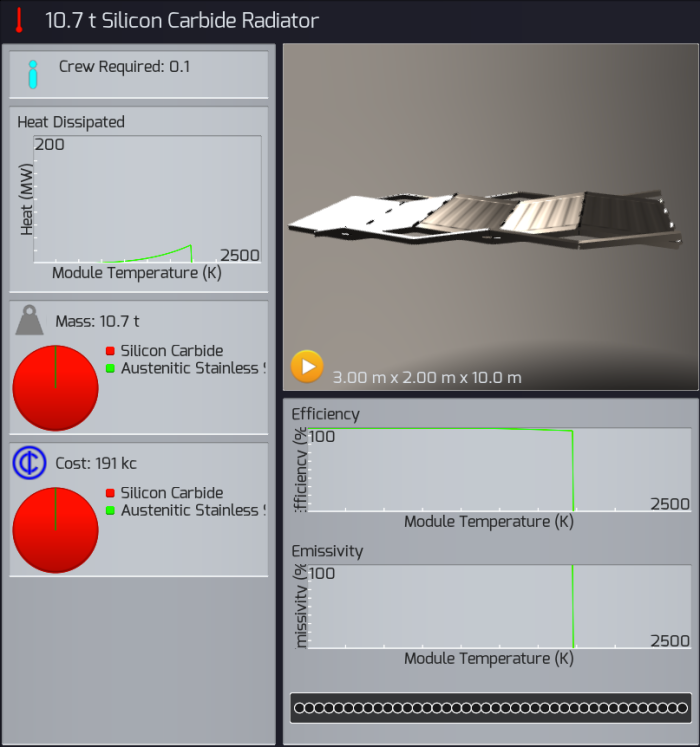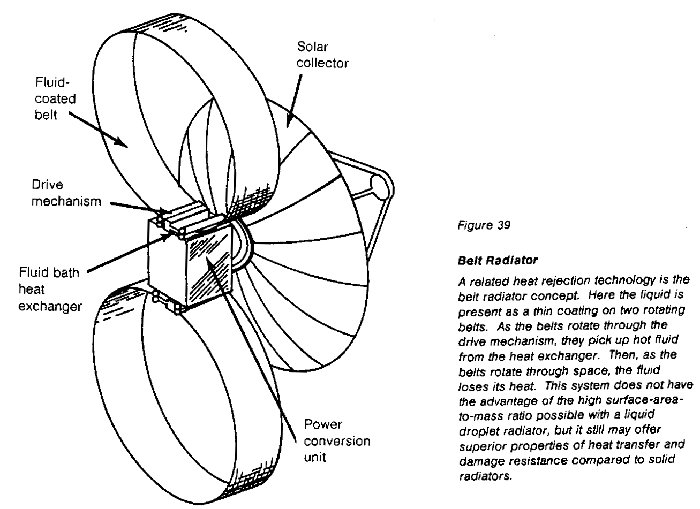Previously, we examined why lasers and exhaust look they way they do, in addition to spacecrafts’ shapes. Now we’ll look more closely at one specific part of spacecrafts: the heat radiators.

Heat radiators are necessary for spacecrafts in order to cool their internal systems. Nuclear reactors produce tremendous amounts of waste heat, and other subsystems produce smaller yet substantial amounts as well. Nuclear-enabled naval ships on Earth can cool their reactors via convection since they are sitting in an enormous bath of coolant already: the ocean. Aircraft and ground craft also have the air to use as coolant to constantly soak away heat.
No such solution exists in space. The lack of any sort of fluid medium in space prevents convective cooling, and there exists no solid material in space to support conductive cooling either. This leaves the one remaining method of cooling: radiation. All materials always radiate photons via Blackbody Radiation, and the amount and kind they do depends on the temperature: hotter materials emit much more energy.
This is where heat radiators come in. These are already in use on the ISS.

They are flat panels with tiny pipes running through their entirety, pumping in scalding hot coolant through one side, and cooled off coolant out the other side. In this way, the radiators form a closed coolant loop with the system that needs cooling. Each set of radiators cools a different system, which is also why some radiators glow orange hot, some glow yellow hot, and some don’t even glow at all (well, they’re actually glowing in infrared, too cold for the visible spectrum).
Unfortunately, you can’t simply dump all of your systems’ coolant loops into a single loop and pipe them through a single enormous radiator because of the second law of thermodynamics. Closed thermodynamic systems will maximize entropy over time. Put another way, heat always flows from hot to cold.
This means that if you have a nuclear reactor running at 1000 K (degrees Kelvin) with its radiators dumping out heat at 1000 K, and you hook it up to a crew module running at 293 K, you have a problem. The crew module and nuclear reactor coolant loop will combine to yield a temperature partway between the two. This will still cool off the nuclear reactor, but then it heats up the crew module until the people inside are cooked.

Why are radiators shaped like that? Heat emitted is directly proportional to surface area, so flat plates are the most mass-efficient way to radiate heat: maximum surface area, minimum volume. The jagged shape is to allow them to be retracted inwards to temporarily reduce heat signature (if enemy missiles are homing on you) or to protect them from damage.
Certain other designs of radiators exist, but many of them have issues. Liquid droplet radiators use a liquid pumped between a sprayer and a collector. The liquid allows a much higher temperature since the boiling point of the material is the limiting temperature instead of the melting point for solid radiators. Problem with this is that temperature is by far not the limiting factor of radiators. Silicon Carbide and other similar refractory ceramics can be heated to excess of 3000 K without melting. Even more exotic materials, like Hafnium Carbide, can exceed 4000 K (For comparison, the Sun’s surface is 5778 K) without melting! Their material properties are weaker at that temperature, but they remain still usable as radiators, and as long as they are never dropped below a certain temperature, they will never crack from thermal expansion stress. For reasons I’ll outline below, the internal systems will never emit coolant hot enough to take advantage of these refractory materials’ high melting points.

The radiators can never be hotter than the system they cool due to the laws of thermodynamics. However, the nuclear reactors in game can reach up to 3000 K, yet the radiators rarely ever exceed half that. In fact, for one of the reactors used for power production only in game, the reactor core never exceeds 1688 K and the radiators radiate at 1200 K. This reactor’s design is shown below.

Why are the temperatures so low when the materials used can withstand temperatures twice as high? Two things: the machinery between the reactor core and the radiators all needs to be able to withstand this heat, and the system works best when the temperature drops.
The reactor uses a thermocouple to convert the heat gradient from the reactor into power (note that a turbine-powered system would have somewhat similar limitations). The thermocouple first must withstand the high temperatures. Thermocouples require materials with high Seebeck Coefficients, and these materials tend to have low melting points. On top of that, the high temperature difference involves very significant thermal expansion stress, which is also not something these materials are good at withstanding.
Secondly, thermocouples are most efficient when the temperature drops significantly across them. This yields an interesting optimization problem. If the temperature drop from reactor to thermocouple is high, then the temperature drop from the radiators to space must be low, and the reverse is true. Remember that radiators perform best when their temperature is high.
This means the more efficient the reactor is at producing power, the harder it is to cool the system. On the other hand, a low efficiency reactor is very good at cooling itself. This problem yields two different valuable qualities that are inversely proportional to each other, and no local maxima can be found for both simultaneously.
In the end, for the above system, the somewhat reasonable point for both properties was at 1688 K for the reactor and 1200 K for the radiators.

That 1200 K temperature is why the largest radiators on spacecrafts glow orange. In fact, you estimate the temperature of radiators by their color, and from that you could estimate their purpose.
What about inter-reflection? Inter-reflection of radiators is a problem, since the heat from one radiator can be re-absorbed into another. This is exacerbated by Kirchhoff’s Law of Thermal Radiation, which states that the emissivity and absorptivity of a material is identical for any given wavelength of light.

Blackbody radiation emits not simply perpendicular to the emitting surface, but in a full hemisphere of directions. Note that the intensity does fall off with the cosine of the angle from the perpendicular, however, so emission is most intense perpendicular to the radiator, and it falls to zero directly parallel to the surface. This does mean that these radiators will suffer inter-reflection, which will reduce their total efficiency, but they still will do the job, and can still be placed next to each other at narrow angles to each other.
Finally, can these radiators be armored? The answer is yes, contrary to what other sources may claim. Radiators are simply panels with material with tubes hollowed out in them to pass coolant through. One can simply increase the panel thickness beyond the tubes to add monolithic armor, and the refractory nature of the radiator materials means they will remain very strong even at orange-hot temperatures.
But, thicker monolithic plating reduces the efficiency of the radiators, because it will negatively impact the Heat Transfer Coefficient of the convection-radiation system. Thus, this yields yet another optimization problem, with radiator protection being inversely proportional to radiator efficiency. One will generally find that the added mass and poorer efficiency is often a fair trade for radiators that can actually withstand a serious beating.
That’s all for radiators! Next time, we’ll look into moment-to-moment space combat itself.
What about venting hot coolant and carrying spare coolant around on the ship. You could use heatpumps to optimize it a bit though that will be a big hit to efficiency. But if you carry spare coolant and you can vent some that would allow you to operate for a short time without radiators, eg retract them when in combat range and rely on venting for cooling, and once the flyby is over extend the vulnerable radiators again. Or just have extra cooling for a few combat passes.
Similar could be done with large heat reservoirs, have them cool and dump heat into them during the combat pass, then use radiators to sink the heat out of them again. The heat-pumps would be inefficient power-wise, but you mostly don;t need to run them and weapons at the same time.
LikeLike
Yeah, heat sinks and reservoirs, as well as heatpumps were all considered, though preliminary estimates indicated that plain radiators were better in terms of mass and efficiency. Still, it’s a highly enough requested feature that I am considering implementing it for later updates.
LikeLike
Neat, hopefully that will get added sometime after the linux version.
LikeLike
I could see either heat sinks, or open-cycle cooling, as being a viable option for drones, since they will likely only ever need to run their reactors at full power for a few minutes of combat at most, being either destroyed at the end, or (presumably) retrieved and restocked with fuel, ammo and coolant after the battle.
LikeLike
The Harrier Jump Jet used water cooling when hovering (“Aircraft and ground craft also have the air to use as coolant to constantly soak away heat.” – but not a hovering Harrier). The worst case calculation allows for 90 seconds of hovering (with a warning light lighting up after 75 seconds, IIRC), but it could be possible to hover for longer. Good luck. – With a spacecraft, I’d probably use something which has a double use as coolant as well as propellant/reaction mass. Like, ya know, contemporary liquid-propellant rocket engines. This would allow for exciting tactical/strategic decision whether to waste propellant for delta-v or waste it to temporarily improve power output. Don’t bother about running out of delta-v, there will always be an Ensign who will be tasked to plot a rescue trajectory to you whenever you happen to jet stuck in an L5 tadpole orbit…
LikeLike
I don’t remember the name, but long metal cables that have hot coolant running through them. It was a way to get closer to stars without melting. Great game btw.
LikeLike
Is there a use for making radiators long and thin like strakes, rather than large like wings? It seems like that could cut down on frontal cross section. (Might even be able to hide some of that behind a mushroom- or spearhead-type nose section, if you were willing to accept the weight penalty for the inside curve behind it.)
LikeLike
In game, both styles are used to certain effect. The winglike radiators can be retracted much better, and reduce the heat signature very quickly (since they are heavily segmented). Strake-like radiators have cross sectional advantages, though there is another issue is that often you run out of space on your ship with that sort of design.
LikeLike
Cool! Thanks again for all your replies; really looking forward to giving it a play.
LikeLike
Another advantage of strake-like radiators over wing-like ones is that they do not suffer from interreflection as badly – and not at all for low numbers of radiators that don’t take up too large a percentage of the ship’s radius, due to the fact that the ship’s hull shadows the other radiator panels from the point of view of one of them.
LikeLike
I just wanted to say thank you very much for this informative article. I’m an indie sci-fi writer and this is a tremendous help for my research.
LikeLike
I feel like orbital guns would have some level of advantage in this regard. Because of their short supply line, any firing they do can be supplemented with coolant to some extent or possibly take advantage of thin atmosphere.
Though I dunno.
LikeLike